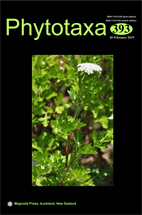Abstract
We present light and scanning electron microscopic observations on the valve ultrastructure of 4 species of the genus Germainiella from the Maolan Nature Reserve from Guizhou Province, China. This is the first report of the genus from China. The new species differ in the shape and size of the valves, but they all have the large conopeum covering the entire face of the valve. One species, G. sinica, lacks small tubules running perpendicular to the raphe opening, one of the defining features of the genus, and in having the large conopeum but lacking the tubules resembles another diatom, Fallacia emmae, described from the subantarctic region. We conclude that Germainiella and Fallacia, as typified by F. pygmaea, are not closely related, but species assigned to Fallacia may be closely related to Germainiella. A new combination, G. emmae, is proposed. We discuss the nature of conopea, and other small, finely-structured naviculoid diatoms that might be better placed in Germainiella. The genus is now recognized to have a total of 7 species, 4 of which are from the Maolan Nature Reserve.

